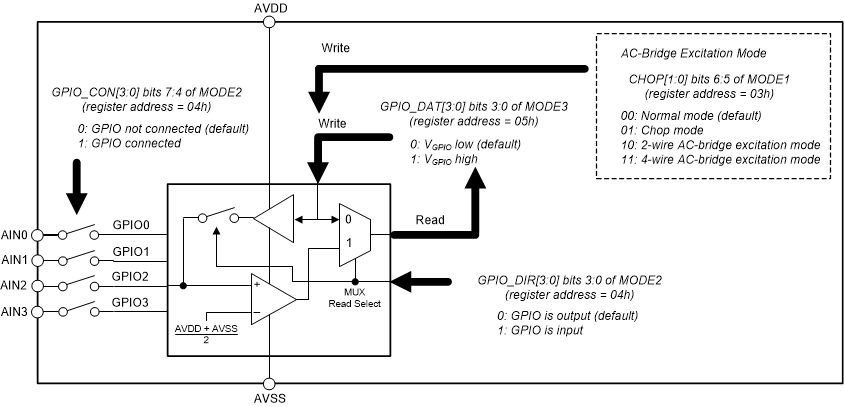ZHCSIU3 September 2018 ADS1235
PRODUCTION DATA.
- 1 特性
- 2 应用
- 3 说明
- 4 修订历史记录
- 5 Pin Configuration and Functions
- 6 Specifications
- 7 Parameter Measurement Information
-
8 Detailed Description
- 8.1 Overview
- 8.2 Functional Block Diagram
- 8.3 Feature Description
- 8.4
Device Functional Modes
- 8.4.1 Conversion Control
- 8.4.2 Chop Mode
- 8.4.3 AC-Bridge Excitation Mode
- 8.4.4 ADC Clock Mode
- 8.4.5 Power-Down Mode
- 8.4.6 Reset
- 8.4.7 Calibration
- 8.5 Programming
- 8.6
Register Map
- 8.6.1 Device Identification (ID) Register (address = 00h) [reset = Cxh]
- 8.6.2 Device Status (STATUS) Register (address = 01h) [reset = 01h]
- 8.6.3 Mode 0 (MODE0) Register (address = 02h) [reset = 24h]
- 8.6.4 Mode 1 (MODE1) Register (address = 03h) [reset = 01h]
- 8.6.5 Mode 2 (MODE2) Register (address = 04h) [reset = 00h]
- 8.6.6 Mode 3 (MODE3) Register (address = 05h) [reset = 00h]
- 8.6.7 Reference Configuration (REF) Register (address = 06h) [reset = 05h]
- 8.6.8 Offset Calibration (OFCALx) Registers (address = 07h, 08h, 09h) [reset = 00h, 00h, 00h]
- 8.6.9 Full-Scale Calibration (FSCALx) Registers (address = 0Ah, 0Bh, 0Ch) [reset = 00h, 00h, 40h]
- 8.6.10 Reserved (RESERVED) Register (address = 0Dh) [reset = FFh]
- 8.6.11 Reserved (RESERVED) Register (address = 0Eh) [reset = 00h]
- 8.6.12 Reserved (RESERVED) Register (address = 0Fh) [reset = 00h]
- 8.6.13 PGA Configuration (PGA) Register (address = 10h) [reset = 00h]
- 8.6.14 Input Multiplexer (INPMUX) Register (address = 11h) [reset = FFh]
- 9 Application and Implementation
- 10Power Supply Recommendations
- 11Layout
- 12器件和文档支持
- 13机械、封装和可订购信息
8.3.5 General-Purpose Input/Outputs (GPIOs)
The ADC includes four GPIO pins, GPIO0 through GPIO3. The GPIOs are digital inputs/outputs that are referenced to analog AVDD and AVSS. The GPIOs are read and written by the GPIO_DAT bits of the MODE3 register. The GPIOs are multiplexed with analog inputs AIN0 to AIN3. As shown in Figure 47, the GPIOs are configured through a series of programming registers. Bits GPIO_CON[3:0] connect the GPIOs to the associated pin (1 = connect). Bits GPIO_DIR program the direction of the GPIOs; (0 = output, 1 = input). The input voltage threshold is the voltage value between AVDD and AVSS. Bits GPIO_DAT[3:0] are the data values for the GPIOs. Observe that if a GPIO pin is programmed as an output, the value read is the value previously written to the register data, not the actual voltage at the pin.
The GPIOs also provide the ac-bridge excitation drive signals. AC-bridge excitation mode overrides the GPIO register data values. See the AC-Bridge Excitation Mode section for details.
 Figure 47. GPIO Block Diagram
Figure 47. GPIO Block Diagram